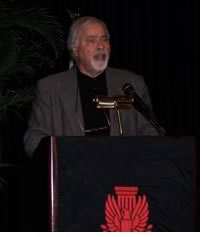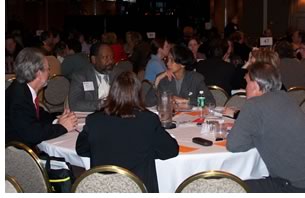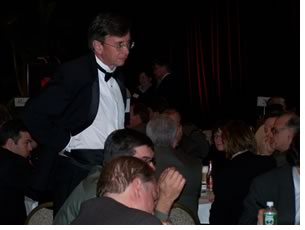

03/2005
Two mayors offer insight and suggestions
 by Heather Livingston
by Heather Livingston
There’s that word again—sesquicentennial. What does it mean—and what will it mean for AIA members?
In 2007, the AIA will celebrate its 150th year of existence, the sesquicentennial (sesqui being Latin for “one and a half”). During the 2005 Grassroots Leadership and Legislative Conference on February 11, AIA Past President and Chair of the Sesquicentennial Blue Ribbon Panel Syl Damianos, FAIA, offered attendees a glimpse of what’s in the works for 2007.
As with any anniversary, the Institute’s plans for marking the occasion do include a certain amount of retrospection through the last 150 years, but the most intriguing element of the pending sesquicentennial is its potential for the future, Damianos explained. In what is being envisioned as a “Blueprint for America,” the sesquicentennial planning task force is working to “harness the profession’s training, creative gifts, and knowledge of the design process” to bring about profound and lasting change in our communities. Looking back over the AIA’s history, it is evident that the profession has played a significant role in advancing the quality of life in American towns and cities. To broaden and build upon that legacy, three primary goals will drive the institute’s celebration:
- Strengthen the profession
- Increase the AIA’s visibility and value
- Encourage “more livable, healthy, and beautiful communities.”
 Although
still in the visioning stage, the AIA’s sesquicentennial
celebration is being embraced as an opportunity to reach beyond the ordinary
and bring about positive change both in our communities and in the profession.
To ensure that these lofty goals are met, the Institute will work closely
with component leaders to identify local advocates who will lead the
initiative in their communities through 2007 and beyond. These “champions” will
bring the message to local officials and media outlets to broaden impact
and awareness. At the national component, leadership will work with collateral
partners—including national, regional, and local architecture foundations—to
develop complementary programming and education and outreach initiatives
that will resonate with communities, civic leaders, teachers, and K–12
students.
Although
still in the visioning stage, the AIA’s sesquicentennial
celebration is being embraced as an opportunity to reach beyond the ordinary
and bring about positive change both in our communities and in the profession.
To ensure that these lofty goals are met, the Institute will work closely
with component leaders to identify local advocates who will lead the
initiative in their communities through 2007 and beyond. These “champions” will
bring the message to local officials and media outlets to broaden impact
and awareness. At the national component, leadership will work with collateral
partners—including national, regional, and local architecture foundations—to
develop complementary programming and education and outreach initiatives
that will resonate with communities, civic leaders, teachers, and K–12
students.
A mayor “who gets it”
Following Damianos’s presentation, AIA President Douglas L Steidl,
FAIA, and Mayor Donald Plusquellic (D-Akron), sat down for an “unrehearsed
conversation [on the role of architects as community design advocates]
with a public official who gets it,” in Steidl’s words. Plusquellic,
who also is currently serving as the president of the U.S. Conference
of Mayors, discussed the need for architects to become more involved
in their communities’ planning. He suggested that local chapters
approach their mayors with one or two strong ideas on how to help solve
particular problems, but leave the door open for other issues the mayors
may want to discuss.
 When
Steidl asked, “Has AIA Akron [Steidl’s hometown] ever
come to you and said, ‘May we help you?’” Plusquellic
responded half-jokingly, “No. I suppose my secretary might have
misplaced the letter, but I’ve been in office 19 years. If you
sent a letter 16 years ago, you might have followed up since then.”
When
Steidl asked, “Has AIA Akron [Steidl’s hometown] ever
come to you and said, ‘May we help you?’” Plusquellic
responded half-jokingly, “No. I suppose my secretary might have
misplaced the letter, but I’ve been in office 19 years. If you
sent a letter 16 years ago, you might have followed up since then.”
Plusquellic offered that by volunteering expertise and service, especially when a new mayor takes office, architects can become a vital resource to the community. “You’ll be repaid many times over by having people understand that, while architects aren’t cheap, the money is well spent,” he said. According to Plusquellic, architects need to understand two things about working with their elected officials. First, cities are increasingly facing more financial pressure as funding is being cut on both the federal and state levels. Second, it’s important that architects get involved at the beginning of municipal projects and to get community buy-in. “Get them involved with what kind of facilities they want. They’ll own the process. The project will look better and function better,” he said. “You have to talk to mayors about the value that you add.”
 Brainstorming the issues
Brainstorming the issues
Bringing the discussion back to the issue of sesquicentennial planning,
the component leaders next participated in a half-hour brainstorming
session on how the architecture community can become more involved
with local officials to enhance the performance and beauty of the built
environment. Questions asked of component executives addressed:
- Resources the national component could provide to assist cooperation with community leaders
- Issues architects most frequently are called upon for by elected officials
- Status of current relationships with mayors and how to improve them
- How components work with community leaders to address problems and find solutions.
Throughout the session, Mayor Plusquellic and AIA Public Director Jeremy Harris, Hon. AIA, the former mayor of Honolulu, walked through the room, participating in table discussions, offering guidance, and lending inspiration.
 Stepping up to lead
Stepping up to lead
At the end of the planning session, Mayor Harris shared his thoughts
on the discourse. “Our cities are in crisis,” he began. “They
are crying out for leadership. Who is better positioned to lead cities
than architects?” He continued, “From the conversations
I heard around the room, there is a disconnect between architects and
politics. Architects aren’t plugged in and mayors aren’t
turning to you for help. They think of architects as builders of buildings,
not builders of community.
“The sesquicentennial is a unique opportunity for your profession. It is the chance to build relationships, form leaders that articulate a vision of the future, and redefine yourselves as builders of community. Redefine yourself in the eyes of the community. You can’t wait for mayors to give you the mantle of leadership. You’ve got to walk the walk. You will receive that leadership role and be well-rewarded.”
Mayor Plusquellic echoed Mayor Harris’s sentiments on the value of architects in the public design process. “Your best position with local government—your key message—is the value you bring. By nature, you are creative problem solvers. How can you solve problems in your local community unless you offer to help?” He continued, “Volunteer to help your city government. Give your mayors some ideas, concepts for solving problems. The value you bring long-term is tremendous. Get your value across.”
Copyright 2005 The American Institute of Architects.
All rights reserved. Home Page ![]()
![]()
 |
||
Photos
by the author.
|
||